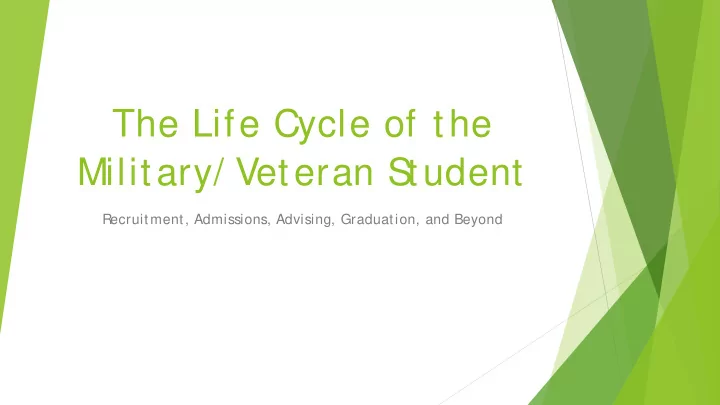

The Life Cycle of the Military/ Veteran S tudent Recruitment, Admissions, Advising, Graduation, and Beyond
Annie Weberpal M.S . Counseling • Global Career Development • Facilitator Advising Coordinator, • College of Letters & S ciences UW-Whitewater WI Army National Guard 2007-2011 • OIF 2009-2010 US Army 2005-2007 •
Recruitment Who are student veterans? Where are they? What attracts them?
Who Are Student Veterans? S tudent veterans are individuals who have served in the United S tates Armed Forces: Army, Navy, Air Force, Marines, Coast Guard They are men, women, transgender, mothers, fathers, husbands, wives, sons, daughters, sisters, brothers, Millennials, Gen Xers, Boomers, married, divorced, single, gay, straight, bisexual, Black, White, Hispanic, Native American, Asian, English language learners, immigrants, leaders, followers A student veteran is in many ways like any other college student And a student veteran is in many ways like no other college student, even other veterans
ht t p:/ / www.va.gov/ vetdata/ docs/ Maps/ Vet Pop14_S t ate.pdf Where are veterans?
ht t p:/ / www.va.gov/ vetdata/ docs/ Maps/ Vet Pop14_Under25.pdf Where are younger veterans?
ht t p:/ / www.va.gov/ vetdata/ docs/ Maps/ Vet Pop14_PercentChange.pdf Where are veteran populations growing?
• 85% Age 24 or older • 47% Married and/ or parent • 27% Female (14% of service population) • 62% First generation Dat a published 30 May 2014 ht t p:/ / www.ncsl.org/ research/ educat ion/ vet erans-and-college.aspx
What Attracts Student Veterans? Geography Academic programs Word of mouth
Marketing Opportunities College Recon https:/ / www.collegerecon.com/ Rally Point https:/ / www.rallypoint.com/ S ervice to S chool http:/ / service2school.org/
Admissions Finding the best fit Choice Act JS T evaluation Credit by exam
Finding the Best Fit Create networks to help students find the path that is best for them Most efficient path to graduation Benefits/ financial counseling Explore potential indifference
Choice Act Enables active duty veterans to pay in-state tuition rate at public institutions in US Within three years of separation Using federal benefits Continuous enrollment How can this benefit your campus? How does this benefit the student?
Joint Services Transcript ACE recommendations Minimum and maximum credits awarded Too many or too few? Miscellaneous vs. direct equivalent Can change student standing to sophomore, j unior First-year supports?
Credit by Exam DS S T (formerly DANTES ) CLEP Credit for prior learning
Advising Perceptions Benefits Choices
Perceptions What perceptions do universities • and colleges have of military students? What perceptions do military • students have of colleges and universities? How can staff change perceptions? • How does your campus view • veterans? How do veterans view your campus? •
Education Benefits • Federal Benefits • S tate Benefits Chapter 30 – Montgomery GI Bill Vary significantly by state Chapter 31 – Vocational Wisconsin GI Bill Tuition Waiver Rehabilitation 128 credits at any UW S ystem or technical school Chapter 33 – Post 9/ 11 GI Bill Various grants and loans Y ellow Ribbon Program for private institutions Chapter 35 – Dependents’ Educational Assistance Chapter 1606, 1607 – Reserve and Guard members
Benefit Restrictions May Impact Educational Choices Full-time vs part-time Payments vary by location Online vs. in-person Failing on purpose S hort-term vs. long-term impacts
Retention High-impact practices Transitions Identity
High Impact Practices (HIPs) Orientation session Lounge/ space on campus S ummer boot camp Veteran Coordinator Themed courses or S sections tudent Organization Leave policies Campus committee Learning community Data collection
In what ways can theory inform our work with student veterans? How can existing theories be applied to the student veteran population?
Identity Development Non-linear for military? Chickering S even vectors and key influences Psychosocial (Erikson, Marcia) Identity diffusion Foreclosed identity and disequilibration Arnett Israeli studies
Schlossberg’s Transition Theory The Four S ’s Situation Trigger, timing, control, role change, duration, experience, concurrent Moving in stress, assessment Moving through Self Moving out Personal/ demographic, psychological Support Partner, family, friends, community/ institutional Strategies Modify, Control, manage
S uper’s Life Career Rainbow Life span and life space Roles: child, student, leisurite, citizen, worker, parent, partner, homemaker How does veteran fit in with other roles? Theaters: home, community, school, workplace Current, future, ideal roles
Graduation & Beyond Military-informed career services Tracking graduates Transitions (again)
Contact Information Annie Weberpal weberpaa@ uww.edu 262-472-1555 University of Wisconsin – Whitewater College of Letters & S ciences
Recommend
More recommend